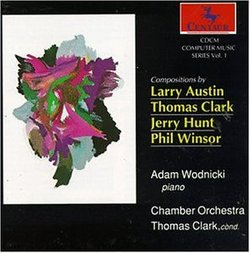| All Artists: Larry [Composer] Austin, Thomas Clark, Jerry Hunt, Phil Winsor, Steven Harlos, Adam Wodnicki Title: CDCM Computer Music Series Vol. 1 - CEMI, University of North Texas Members Wishing: 1 Total Copies: 0 Label: Centaur Release Date: 11/3/1993 Album Type: Import Genre: Classical Style: Number of Discs: 1 SwapaCD Credits: 1 UPC: 789368051229 |
Search - Larry [Composer] Austin, Thomas Clark, Jerry Hunt :: CDCM Computer Music Series Vol. 1 - CEMI, University of North Texas
 | Larry [Composer] Austin, Thomas Clark, Jerry Hunt CDCM Computer Music Series Vol. 1 - CEMI, University of North Texas Genre: Classical
|
Larger Image |
CD Details |
CD ReviewsHardly sounds like computers at all! Steve Benner | Lancaster, UK | 07/23/2001 (4 out of 5 stars) "As the Consortium to Distribute Computer Music is headed up by Texan composer Larry Austin, it is perhaps not surprising that this first volume in CDCM's ambitious programme of releases features music from the Center for Experimental Music and Intermedia (CEMI) at the University of North Texas, Denton (of which Austin was co-director for many years). It includes two substantial works by Austin himself, in addition to works by three of his erstwhile colleagues. Austin's "Sinfonia Concertante: A Mozartean Episode" (16:47) is scored for chamber orchestra (represented on this recording by the Chamber Orchestra, conducted by Thomas Clark), playing very much in the style of Mozart accompanied by a computer generated narrative. This latter is a tape part produced by various computer manipulations of a spoken voice (Stefan Hurdalek) reading extracts (in English translation) from Mozart's letters to his father, from 1777-78. In common with much of Austin's music for orchestra and tape, the tape part is never dominant, nor overpowering, but serving as just one more instrument within the whole. The computer processing applied in this case is generally little more than the application of filtering (especially comb filtering) and never obscures Mozart's words. The other Austin piece on the disc is his "Sonata Concertante" for piano and computer music on tape. This 12-minute work is a complex interplay between the pianist and a computer-generated tape part that simulates and expands the piano in such a way that it is often not possible to tell just which is which. Thomas Clark's "Peninsula" (8:23) is also a work for piano and tape. In this case, the tape part consists of a pointillistic texture of Synclavier-(re)synthesised acoustic instruments, which combines with the piano sonorities (played like the other piano works on this disc by Adam Wodnicki) as waves breaking over a coruscated shoreline. The closing piano work on the disc is Phil Winsor's "Dulcimer Dream" for amplified piano. This 6-minute work qualifies for inclusion on a disc of computer music through consisting of computer-generated melodic patterns, designed to create an uninterrupted flow of rapid pulses to build and sustain resonant drone structures, accentuated by the electronic amplification of the piano. The remaining work on the disc is the late Jerry Hunt's "Fluud" for dual Synclaviers, performed by the composer. At just over 17 minutes in duration, this is the longest work on the disc, and for many may prove to be the hardest listening. It is the most electronically textured of the works presented, and while it may owe something of its harmony and gestural structure to earlier times (the piece is very much an homage to the 17th century mystic, Robert Fludd (sic)) it is hard to grasp any larger-scale structure in the work without repeated listenings. In reality, I suspect that any large-scale structure discerned in the piece is more accidental than intentional: in performance, the player triggers several channels of pre-loaded trills and tremolos with a rapid trilling on the Synclaviers' keyboards, deliberately flooding the machines' operating systems so that they simply cannot keep up with the player's demand for notes! The piece was also conceived partly as a theatrical work (the composer describes it as "an aural-visual performance extraction") and without the visual element, the faltering and stuttering utterances of the struggling Synclaviers is often more painful than entertaining. Perhaps that is what the composer intended, though...As with many CDCM issues, the included sleeve notes are frustratingly minimal, with little detail about the composers or their works, and almost nothing about the computational or compositional techniques employed. The dates of composition of the 5 works on this disc are not even given: I would guess that most of them date from not too long before the disc's recording in 1987 ("Fluud" dates from about 1985, I believe), although the Austin pieces in particular could well be older. Lack of these details is a shame, considering the undoubted historical value that the CDCM series will acquire. If you are at interested in experimental computer music from the leading American schools, then this CD (like most the rest of the CDCM issues) should be on your shopping list."
|

 Track Listings (5) - Disc #1
Track Listings (5) - Disc #1